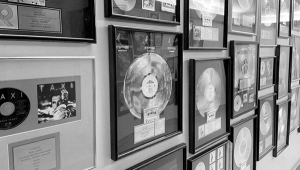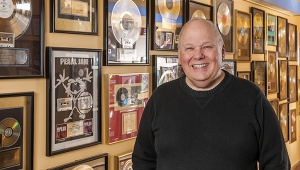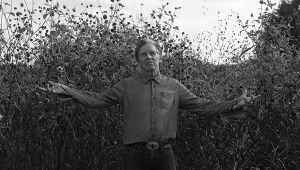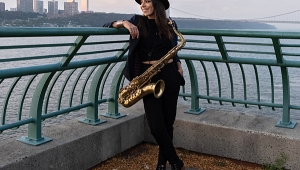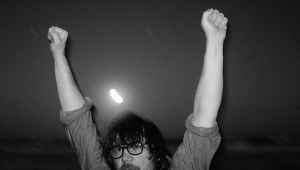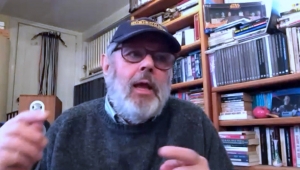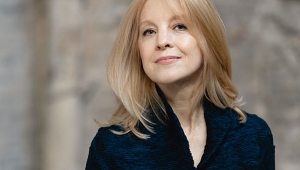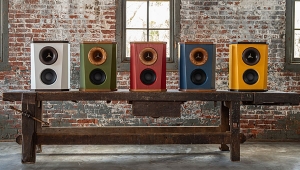| Columns Retired Columns & Blogs |
Poem: Stereophile Cuts an LP The Music
The Music: Denis Stevens
Charles Tomlinson Griffes: Poem (1918) When he wrote this wonderfully colorful Poem for flute and orchestra, here performed in a version with piano made by Georges Barrère, Griffes was director of music at the Hackley School in Tarrytown, New York. In a comparatively short creative span of a dozen or so years, following a period of intensive study in Berlin, he had produced many works in the German romantic style, in his own particular vein of impressionism, and in a highly personalized quasi-oriental idiom. One would hardly think of him—after hearing the Poem—as a pupil of Humperdinck, but his technical grounding was solid and faultless. Later influences, including Japanese art, literature, and theater, were to play a major part in changing his outlook. Stokowski gave the first performances of orchestral works written in 1918 and 1919, and on November 16, 1919, Walter Damrosch and the New York Symphony Orchestra introduced the Poem, with Barrère as soloist.
"For three hundred years flutists tried to play in tune. Then they gave up and invented vibrato," quipped Barrère to one of his last pupils. The eminent French-born virtuoso, founder of the New York Flute Club in 1920, was nothing if not a tonal colorist, and his own fat vibrato was (to quote his own words) simply a method of "setting the air around the player into vibration." The Poem, which reflects like a motionless and many-hued pool of water virtually everything within the capabilities of the flute, shows us its purity of tone, its range, and its extraordinary aptitude for what can best be described as speech-patterns. Like a song without words, this poem without rhyme nevertheless tells a story that will match to perfection whatever floats uppermost in the listener's thoughts. It is a masterpiece of suggestion, flexibility, and unrivaled technical wizardry.
Carl Reinecke: Sonata in E, Op.167 ("Undine") (1885) Theophrastus Bombastus von Hohenheim, a disputatious and iconoclastic student of chemistry and alchemy otherwise known as Paracelsus, who lived from 1490 to 1541, admitted Undine as one of his elemental spirits, a water-sprite created without a soul, but able to acquire one by marrying a mortal and bearing him a child. Thus having inherited all the pains and penalties of humanity, she vanished from view until the early years of the nineteenth century, when Friedrich Baron de la Motte Fouqué decided to refurbish the ancient tale in 1811 and transform it into what became a veritable symbol of German Romanticism.
E.T.A. Hoffman wrote an opera on the subject in 1816, but the score was edited by Pfitzner only in 1906, and it has never become a favorite even in Germany. There was another opera by Lortzing (April 21, 1845) and a Russian attempt by Alexis Lvov (September 20, 1848), but since that time very little of note until the play Ondine by Jean Giraudoux. Ravel's piano piece, based on a poem by Aloysius Bertrand, takes us back to the nymph of Paracelsus, so it was really Reinecke, a fine pianist, conductor, administrator, and a prolific composer to boot, who took up the watery tale once more in a Schumannesque sonata composed about 1885. He was well-fitted for such a task, since his fairy tales for female voices and piano had proved considerably popular with young people. He was an accomplished musician of many talents, and shortly after producing his four-movement flute sonata he arranged it for clarinet or violin. In this recording, some cues for these instruments in the G-major section of the Intermezzo are played by Gary Woodward on an alto flute.
According to Fouqué's story, Undine is adopted by a poor fisherman and his wife, and, falling in love with a knight named Huldbrand, she accepts his proposal and upon marriage acquires a soul. Alas, his roving eye lights upon Bertalda, thought to be the daughter of a duke, but in fact the long-lost child of the fisher couple. The water-sprite Kühleborn comes to warn Undine, but is rebuked by Huldbrand, who thereupon marries Bertalda. Undine, understandably annoyed, reappears and kills him with a kiss.
Because there is no apparent story-line connection with the sonata, listeners can easily invent their own interpretation. Aqueous arpeggios dominate the sonata's expressive piano part, while the flute is given up to impassioned and all-pervading themes of an equally fluid nature. This is a work of ingenuity, charm, and distinctive character, the basic thought of whose music will not pass unremarked. The movements are: Allegro; Intermezzo (Allegretto vivace); Andante tranquillo; Finale (Allegro molto agitato ed appassionato, quasi presto).
Sergei Prokofiev: Sonata in D, Op.94 (1943) Engaged for the most part in massive and meaningful works in the midst of war, though happily far from its immediate effects, Prokofiev began to sketch his Sonata for Flute and Piano almost as a distraction, "perhaps inappropriate at the moment, but pleasant," as he told his friend Miaskovsky. Nevertheless, it was the result of a commission from the Committee on Artistic Affairs, which the composer had sought out in the belief that the flute was insufficiently represented in musical literature. That was largely true, but the original inspiration derived from two earlier periods.
The first of these was his practical experience of conducting at the Moscow Conservatoire, when, having got little out of Rimsky-Korsakov's excellent class in orchestration, he enrolled in the student orchestra under Tcherepnin. There he came to know and love the classical repertory of Mozart and Haydn, noting in particular the staccato phrases for flute and bassoon which he introduced into his Classical Symphony. The second inspiration came to him when he was living in Paris, and he always remembered the "heavenly sound" of the virtuoso flutist Georges Barrère, already an internationally known artist.
Prokofiev began his sonata in Alma-Ata, where he was working with Eisenstein on Ivan the Terrible in 1942. He completed it the following year at Perm, where the greater part of his time was taken up by the piano score of the ballet Cinderella. It was premiered in Moscow on December 7, 1943 by Nicolai Kharkovsky and Sviatoslav Richter, and hailed as a work of great charm and significance. Oistrakh and other violinists (notably Szigeti, who edited the flute part for violin) took an interest in its success.
The four movements, rich in lyrical and humorous melodies, show the flute as a wonderfully flexible and expressive instrument. But Prokofiev the pianist, brilliant and resourceful, is never out of the picture, so that the sonata forms a true partnership in style and content. The first movement (Moderato, 4/4) exploits and expounds themes of a direct, clear, and sunny nature, interspersed with bright and breezy passages of an open-air character. In the Scherzo (Presto, 3/4), jaunty cross-rhythms maintain a lively staccato theme and dialoguing upward-soaring runs, with a slightly quicker interlude in the guise of a rustic song. The Andante (2/4) spins a fine melody not without unusual turns, the middle section calling for complex coordination between the two instruments. The finale (Allegro con brio, 4/4) returns to Prokofiev's most extravert and playful mood, with a profusion of ornament for the flute and typical percussive effects for the piano. The flute is rarely silent, the piano never, and the entire impression is one of sheer exuberance and impetuosity.
Robert Schumann: Three Romances, Op.94 (1849) These Romances were composed in 1849, when Schumann was revising his opera Genoveva and working on various shorter pieces, instrumental and vocal, such as the Adagio and Allegro for horn, the Fantasiestücke for clarinet, and the Fünf Stücke im Volkston for cello. Their role is confidently summed up by Sir Thomas Beecham: "According to Nietzsche, Schumann and his contemporaries, including Mendelssohn, were merely an episode or interruption in the orderly flowing tide of German musical history; but while this may be true or not of the others, it is an entire misreading of Schumann's place in it. Far more completely national and unmistakably representative than any before or since is his, the genuine voice in song of his countrymen; and all that is best in the German soul is enshrined here as a witness to the world of what has been and in days to come may be again."
- Log in or register to post comments

